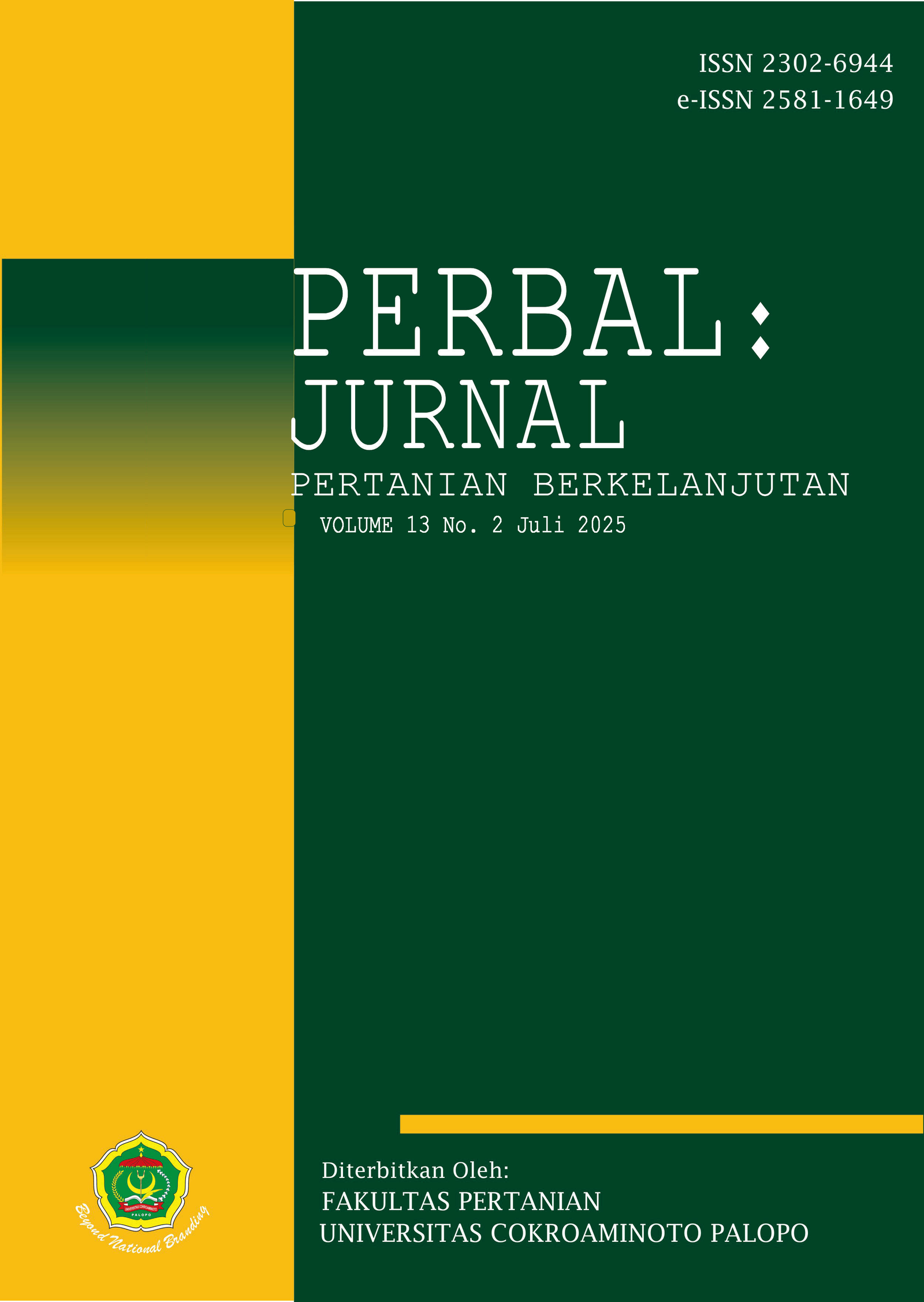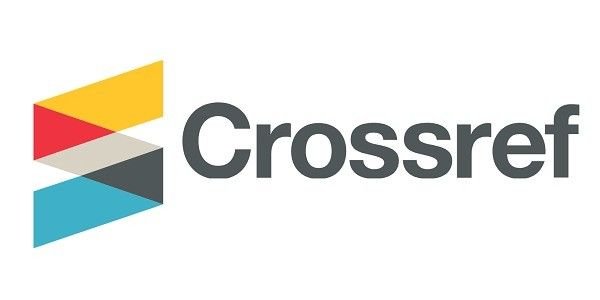Respons Hasil Tanaman Jagung Manis (Zea mays L. saccharata) Terhadap Aplikasi Beberapa Dosis Pupuk Hayati Trichoderma sp.
Response of Sweet Corn Crops (Zea mays L. saccharata) to the Application of Several Doses of Trichoderma sp.
DOI:
https://doi.org/10.30605/perbal.v13i2.6469Keywords:
Jagung manis, pupuk hayati, Trichoderma sp.Abstract
Jagung manis merupakan salah satu varietas jagung komersial di Indonesia. Kebutuhan jagung manis di Indonesia masih rendah sedangkan permintaan konsumsi jagung manis terbilang tinggi. Penggunaan teknologi yang inovatif diupayakan dapat meningkatkan produktivitas dan produksi. Upaya yang bisa dilakukan yakni salah satunya dengan memanfaatkan biofertilizer. Jamur Trichoderma sp. merupakan salah satu mikroorganisme yang dikenal biofungisida fungsional. Trichoderma sp. dapat berfungsi sebagai agen hayati pertumbuhan tanaman, dan dapat pula sebagai organisme pengurai. Tujuan dari penelitian ini adalah untuk melihat respons hasil tanaman jagung pada aplikasi pupuk hayati Trichoderma sp. dengan berbagai dosis. Penelitian dilakukan pada bulan November 2023 sampai dengan Januari 2024 di kebun percobaan Rawasari, Kelurahan Munjuljaya, Kabupaten Purwakarta. Penelitian ini menggunakan Rancangan Acak Kelompok (RAK) dengan 5 perlakuan dosis Trichoderma sp. yaitu: 0 g; 15 g; 30 g; 45 g; dan 60 g. Kombinasi perlakuan ada 5 dengan 5 kali ulangan. Variabel pengamatan yaitu komponen hasil (bobot tongkol dengan kelobot, bobot tongkol tanpa kelobot, panjang tongkol dan diameter tongkol). Hasil penelitian menunjukkan bahwa pada komponen hasil respon terbaik yaitu perlakuan 60 gr dosis Trichoderma sp. terhadap bobot tongkol dengan kelobot (268,35 g), bobot tongkol tanpa kelobot (240,35 g), panjang tongkol (29,91 cm) dan diameter tongkol (4,98 cm).
Sweet corn is one of the commercial maize varieties in Indonesia. The demand for sweet corn in Indonesia is still low while the demand for sweet corn consumption is high. The use of innovative technologies is sought to increase productivity and production. One of the efforts that can be done is by utilizing biofertilizer. Trichoderma sp. is one of the microorganisms known as functional biofungicide. Tricodherma sp. can function as a biological agent of plant growth, and can also be a decomposing organism. The purpose of this study was to see the response of corn plant yield to the application of Trichoderma sp. biofertilizer with various doses. The research was conducted from November 2023 to January 2024 at the Rawasari Experimental Farm, Munjuljaya Village, Purwakarta Regency. This study used a Randomized Group Design (RGD) with 5 treatment doses of Trichoderma sp. namely: 0 g; 15 g; 30 g; 45 g; and 60 g. There were 5 treatment combinations with 5 replications. The observation variables were yield components (cob weight with kelobot, cob weight without kelobot, cob length and cob diameter). The results showed that in the yield component the best response was the treatment of 60 gr dose of Trichoderma sp. on the weight of cob with kelobot (268.35 g), cob weight without kelobot (240.35 g, cob length (29.91 cm) and cob diameter (4.98 cm).
Downloads
References
Ainiya, M., Fadil, M. & Despita, R. (2019). Peningkatan pertumbuhan dan hasil jagung manis dengan pemanfaatan trichokompos dan POC daun lamtoro. Agrotechnology Research Journal, 3(2), 69-74. DOI: https://doi.org/10.20961/agrotechresj.v3i2.31910
Airlangga, S.S.D., Munir, M., & Poniman. (2021). Pengaruh pemberian biochar terhadap beberapa sifat biokimia tanah dan pertumbuhan tanaman bawang merah pada lahan tercemar residu pestisida. Jurnal Tanah dan Sumberdaya Lahan, 8(1), 27-34. DOI: https://doi.org/10.21776/ub.jtsl.2021.008.1.4
Chan, K.Y., Zwieten, L.V., Meszaros, I., Downie, A. & Joseph, S. (2007). Using poultry litter biochars as soil amendments. Australian Journal of Soil Research, 46(5). DOI: https://doi.org/10.1071/SR08036
Charisma, A.M., & Rahayu, Y.S. (2012). Pengaruh kombinasi kompos trichoderma dan mikoriza vesikular arbuskular (MVA) terhadap pertumbuhan tanaman kedelai (Glycine max (L.) Merill) pada media tanam tanah kapur. LenteraBio, 1(3), 111–116.
Dewi, S.M.S., Ningtyas, D.N.Y., Amalia, I.S., & Ramadhan, R.A.M. (2024). Respons pertumbuhan tanaman jagung (Zea mays L.) terhadap pemberian beberapa dosis pupuk hayati Trichoderma sp. Biogenerasi, 9(1), 670-675.
Gusnawaty, H., Taufik, S.M., Bande, L.O.S., & Asis, A. (2017). Efektivitas beberapa media untuk perbanyakan agens hayati Trichoderma sp. Jurnal Hama dan Penyakit Tumbuhan Tropika, 17(1), 70-76. DOI: https://doi.org/10.23960/j.hptt.11770-76
Khairiyah, Khadijah,S., Iqbal,M., Erwan, S., Norlian, & Mahdiannoor. (2017). Pertumbuhan dan hasil tiga varietas jagung manis (Zea mays saccharata Sturt) terhadap berbagai dosis pupuk organin hayati pada lahan rawa lebak. ZIRAA’AH, 42(3), 230-240.
Kurniaty, R., Budiman, B. & Surtani, M. (2010). Pengaruh media dan naungan terhadap mutu bibit suren (Toona sureni MERR.). Jurnal Penelitian Hutan Tanaman, 7(2), 77- 83. DOI: https://doi.org/10.20886/jpht.2010.7.2.77-83
Kusparwanti, T.R., Eliyatiningsih., Rohman, H.F., Indriani, R., & Murty, F.K. (2022). Respon pertumbuhan dan hasil tanaman jagung manis dengan pemberian pupuk organik yang diperkaya Trichoderma sp. Jurnal Cemara, 19(2). DOI: https://doi.org/10.24929/fp.v19i2.2242
Lehar, L. (2012). Pengujian pupuk organik hayati (Trichoderma sp.) terhadap pertumbuhan kentang (Solanum tuberosum L). Jurnal Penelitian Pertanian Terapan, 12(2), 115-124.
Meriati. (2019). Pertumbuhan dan hasil jagung manis (Zea mays sacharata) pada pertanian organik. Jurnal Embrio, 11(1), 24-35.
Maghfirotun, N., Proborini, M.W., & Astarini, I.A. (2022). Pengaruh pemberian kombinasi endomikoriza glomus dan jamur trichoderma terhadap produktivitas tanaman jagung (Zea mays L.). Metamorfosa: Journal of Biological Sciences, 9(2), 256-266. DOI: https://doi.org/10.24843/metamorfosa.2022.v09.i02.p04
Nelvia, Rosmimi, & Sinaga, J. (2010). Pertumbuhan dan produksi jagung manis (Zea mays var saccharata Sturt) pada tanah gambut yang diaplikasi amelioran dregs dan fosfat alam. J. Sagu, 9(2), 20-27.
Palungkun. R., & Asiani, B. (2004). Sweet corn – Baby corn: Peluang Bisnis, Pembudidayaan dan Penanganan Pasca Panen. Penebar Swadaya. Jakarta. 80 Hal.
Putri, H.A. (2011). Pengaruh Pemberian Beberapa Konsentrasi Pupuk Organik Cair Lengkap (POCL) Bio Sugih Terhadap Pertumbuhan dan Hasil Tanaman Jagung Manis (Zea mays saccharata Sturt.). Fakultas Pertanian Universitas Andalas. Padang.
Retno, A., & Sri, D. (2009). Pengaruh dosis kompos dengan stimulator trichoderma terhadap pertumbuhan dan produksi tanaman jagung (Zea mays L.) varietas Pioner -11 pada lahan kering. Jurnal BIOMA, 11(2), 69-75. DOI: https://doi.org/10.14710/bioma.11.2.69-75
Salisbury, F.B. & Ross, C.W. (1995). Fisiologi Tumbuhan Jilid III. Bandung. Institut Teknologi Bandung. 343 hal.
Sepwanti, C., Rahmawati, M., & Kesumawati, E. (2016). Pengaruh varietas dan dosis kompos yang diperkaya trichoderma harzianum terhadap pertumbuhan dan hasil tanaman cabai merah (Capsicum annuum L.). Jurnal Kawista Agroteknologi, 1(1), 68-74.
Sohi, S., Lopez-Capel, E., Krull, E. & Bol, R. (2009). Biochar, Climatechange and Soil: A Review to Guide Future Research. Rep. No. 05/09. CSIRO. ISSN :1834-6618.
Sulaiman, & Frisella, E. (2021). Pengaruh pemberian Trichoderma harzanium dan jarak tanam terhadap pertumbuhan dan hasil tanaman jagung manis. Jurnal Agrida, 1(1), 18–25.
Verdiana, V.A, Thamrin, H.S., & Sumarni, T. (2016). Pengaruh berbagai dosis biochar sekam padi dan pupuk NPK terhadap pertumbuhan dan hasil tanaman jagung (Zea mays L.). Jurnal Produksi Tanaman, 4(8).
Wahyuno, D., Manohara, D., & Mulya, K. (2009). Peranan bahan organik pada pertumbuhan dan daya antagonisme Trichoderma harzianum dan pengaruhnya terhadap P. capsici. pada tanaman lada. Jurnal Fitopatologi Indonesia, 7, 76−82.
Widowati, L.R., Widati, S., Jaenudin, U. & Hartatik, W. (2005). Pengaruh Kompos Pupuk Organik yang Diperkaya dengan Bahan Mineral dan Pupuk Hayati terhadap Sifat-sifat Tanah, Serapan Hara dan Produksi Sayuran Organik. Laporan Proyek Penelitian Program Pengembangan Agribisnis, Balai Penelitian Tanah.
Yusdian, Y., Santoso, J., & Ramadhan, R.A. (2022). Pengaruh takaran mikoriza vesikula arbuskula dan pupuk SP 36 terhadap pertumbuhan dan hasil tanaman jagung manis (Zea mays saccharata L.) varietas talenta. Jurnal Ilmiah Pertanian AgroTatanen, 4(2), 27-34. DOI: https://doi.org/10.55222/agrotatanen.v4i2.836
Downloads
Published
Issue
Section
License
Copyright (c) 2025 Sheli Mustikasari Dewi, R. Arif Malik Ramadhan

This work is licensed under a Creative Commons Attribution 4.0 International License.
In submitting the manuscript to the journal, the authors certify that:
- They are authorized by their co-authors to enter into these arrangements.
- The work described has not been formally published before, except in the form of an abstract or as part of a published lecture, review, thesis, or overlay journal.
- That it is not under consideration for publication elsewhere,
- That its publication has been approved by all the author(s) and by the responsible authorities – tacitly or explicitly – of the institutes where the work has been carried out.
- They secure the right to reproduce any material that has already been published or copyrighted elsewhere.
- They agree to the following license and copyright agreement.
License and Copyright Agreement
Authors who publish with Onoma Journal: Education, Languages??, and Literature agree to the following terms:
- Authors retain copyright and grant the journal right of first publication with the work simultaneously licensed under Creative Commons Attribution License (CC BY 4.0) that allows others to share the work with an acknowledgment of the work's authorship and initial publication in this journal.
- Authors are able to enter into separate, additional contractual arrangements for the non-exclusive distribution of the journal's published version of the work (e.g., post it to an institutional repository or publish it in a book), with an acknowledgment of its initial publication in this journal.
- Authors are permitted and encouraged to post their work online (e.g., in institutional repositories or on their website) prior to and during the submission process, as it can lead to productive exchanges, as well as earlier and greater citation of published work.














